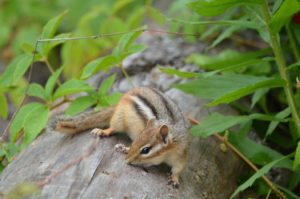As the largest heron in North America, the great blue heron stands about one metre tall.
Fast Facts
Common name: Great blue heron
Scientific name: Ardea herodias
Type: Bird
Diet: Carnivore
Group name: Colony
Weight: 2 to 3 kilograms
Wingspan: 1.6 to 2 metres
COSEWIC Status: Special concern (fannini subspecies)
Did you know?
Great blue herons are generally expert fishers but have also been known to choke themselves to death by trying to swallow fish that are too large to fit down their long, S-shaped necks.
Physical characteristics and behaviour
Standing about one metre tall, the great blue heron is the largest heron in North America. This bird has greyish-blue feathers on its body, a white head with a black stripe on each side, and a long neck and legs. It has a thin, extended, yellow-orange beak and displays brighter feathers during mating season. Great blue herons have a large wingspan and can fly up to 55 kilometres per hour. During flight, they often hold their necks in an “S” curve.
Water and land are both necessary for the great blue heron. It hunts in both salt and freshwater but builds its nest in trees, bushes or on the ground. To hunt, a heron will either stand completely still and wait patiently for its prey or will wade into the water to drive its prey out. When the time is right, it will lunge its neck into the water and usually swallow the prey in one gulp.
Great blue herons breed in colonies, numbering anywhere from dozens to hundreds of nesting pairs. They build their nests out of sticks and line them with moss, grass or pine needles. Sometimes these nests are quite large, measuring up to one metre across!
Diet
Great blue herons primarily eat fish, amphibians, insects and other small animals.
Habitat and distribution
Great blue herons are Canada’s most widespread heron and are found from the Maritimes to British Columbia. Most of the Canadian population of this species is here only during the breeding season. When rivers and lakes begin to freeze up in the late autumn, herons head south, though some living on the Pacific and Atlantic coasts stay year-round.





